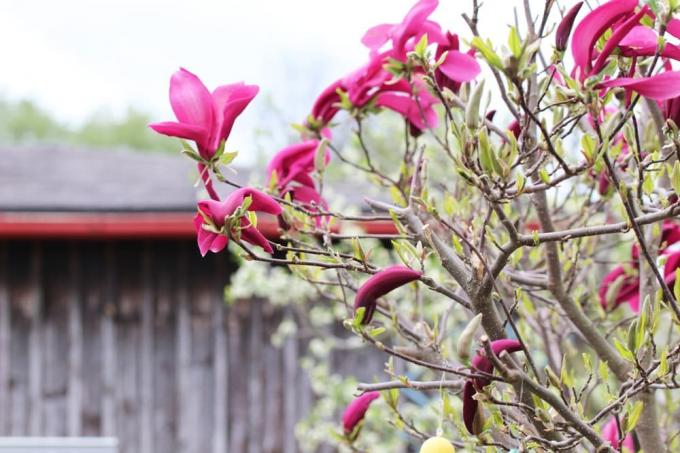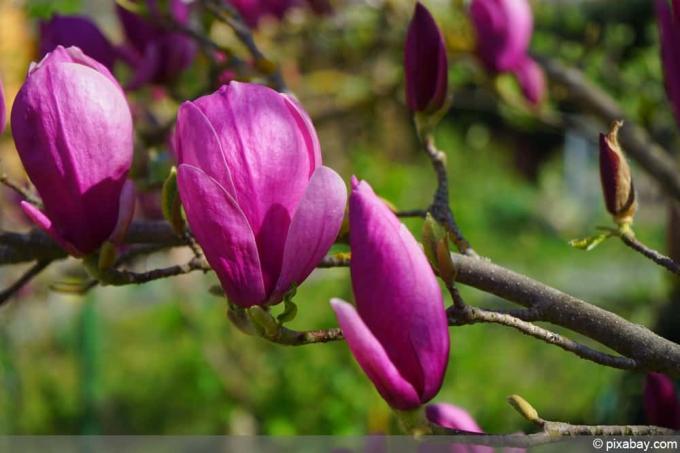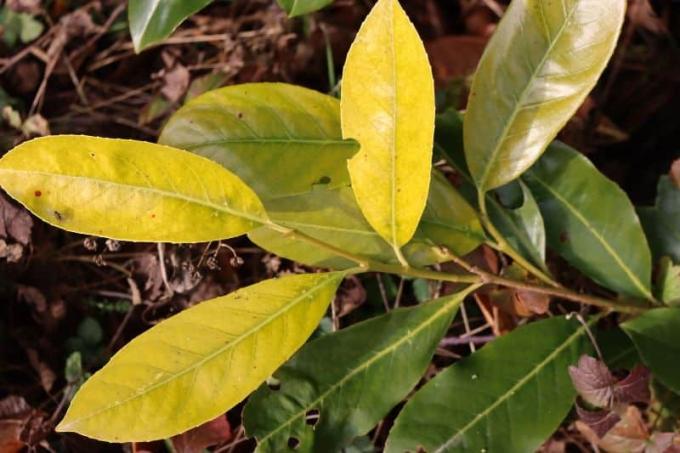

Table of contents
- Crimson magnolia care
- Location
- plants in the open air
- plants in the bucket
- substrate & soil
- Fertilize
- Pour
- Cut
- multiply
- repot
- hibernate
- Hibernation outdoors
- Hibernation in bucket
- Care mistakes, diseases or pests
The purple magnolia 'Susan' is one of the most popular varieties of magnolia trees in domestic gardens because of its purple flowers. Whether cultivated in the front yard, as a solitaire on a garden lawn or in a bucket due to lack of space, the Magnolia liliiflora cuts a fine figure everywhere. However, it needs a little care if the deciduous shrub or tree is to remain beautiful for a long time.
Crimson magnolia care
The purple magnolia is characterized by its beautiful flower color. The deciduous tree or shrub requires the same care as all magnolia trees. However, the graceful plant is also often cultivated in a bucket and thus finds a place next to or on a terrace, for the balcony it is usually too big even in the bucket. A front garden is also enhanced by Magnolia liliiflora. With the right care, magnolias can grow very old and therefore please their owner for many years.
Location
Magnolias like it when planted as a specimen. There should be enough space around the tree. Since the crown can be very sprawling, at least four square meters should be allowed all around, even with smaller varieties such as Magnolia liliiflora. Otherwise, the location should be chosen as follows:
- sheltered from east winds
- otherwise the flowers will be lost
- ideal in front of a house wall or in a corner of a building
- in milder climates also free in a meadow
- light and full sun to partial shade
- at least four hours a day, preferably more, sun
- in a tub on a sheltered terrace or balcony
plants in the open air
The ideal planting time for the purple magnolia 'Susan', which is usually sold in bales, is autumn and early spring before it buds. But just when a cold and frosty winter is imminent, planting should be postponed to spring if the magnolia tree is to be cultivated outdoors. Then it can grow over the year and has become strong enough for the coming winter. When planting, proceed as follows:
- dig a big hole
- about twice the bale size
- create drainage to prevent waterlogging
- Spread stones or gravel on the bottom of the hole
- Fill the hole with water
- Remove old soil from root balls
- Insert magnolia tree
- Enter prepared soil
- Firm the soil well and water again
So that the purple magnolia can root well, it should be watered heavily for the first few days.
Tip:
If a magnolia tree is to be purchased, then this should be done at the exact time when the time for planting is given. The plant should not be left without soil for longer than necessary. If the magnolia was purchased in autumn and should only be in the garden in spring, it is a good idea recommend putting them in a bucket with fresh soil for the winter and protecting them from too much frost protection.
plants in the bucket

Purple magnolias are well suited for cultivation in a container. So if you don't have space in the garden, you can also place a Magnolia liliiflora on the terrace or a larger balcony. The pot should always be twice as big as the ball of the purchased magnolia. The procedure for planting is as follows:
- Create drainage to prevent waterlogging
- Gravel or broken pottery over the drain hole
- lay plant fleece over this
- fill in some of the prepared soil
- water well
- Remove soil from bales
- insert trees
- Fill in the rest of the soil and press down well
- water well again
- empty the collecting plate after a while
Tip:
If the magnolia tree is planted in the tub in autumn, it should be placed directly on a bright and cool, frost-free place and only in the next spring its location on the terrace, balcony or in the find front yard.
substrate & soil
The soil is humic, slightly acidic and evenly moist. It is ideal if the soil is also covered with sand, because the magnolias are more frost hardy here. Moist clay soils, on the other hand, freeze faster, so sand should always be mixed into the soil. Waterlogging must also be avoided. Before the first planting, the soil at the location in the garden should be prepared as follows:
- Fold in compost
- Peat for pH
- sand for permeability
The soil should be mixed accordingly a few weeks before planting, then the minerals in the compost can penetrate Microorganisms in the soil are already developing their full effect, the soil is optimally supplied with nutrients when the young tree is used.
Tip:
Special rhododendron or azalea soil is suitable for plants cultivated in tubs, as it is already slightly acidic and permeable.
Fertilize
Since the root system of the magnolia tree runs very superficially just below the surface of the earth, fertilizer should not be worked into the soil. Because the tree reacts very sensitively to any tillage. Therefore, a rake should not be used around the purple magnolia. So the magnolias should be fertilized as follows:
- Scatter horn shavings
- Use organic fertilizer
- before planting, enrich the soil with compost
- only fertilize twice a year
- once in spring before budding
- in autumn to increase resistance to the cold
- cultivated in a bucket should be fertilized every two weeks
Tip:
Purple magnolias that have been cultivated in a container can also be supplied with liquid fertilizer on a regular basis. It is important that this should not contain any lime and keeps the soil slightly acidic with its active ingredients. Fertilizer for azaleas or rhododendrons is also well suited.
Pour
Magnolias need a lot of moisture, but waterlogging should be avoided at all costs. The naturally falling rain is usually sufficient here. Only in summer does it have to be watered during very hot periods. This should be done as follows:
- when the soil has dried up, water
- only water in the early morning or late evening hours
- Magnolias do not tolerate lime
- therefore water with collected rainwater
- alternatively use filtered tap water
- Cover soil with bark mulch in summer
- keeps the moisture in the soil
Cut

Purple magnolias, like all magnolia species, do not like being cut. The most beautiful growth is always achieved when the tree or shrub is allowed to grow unhindered. But every now and then a small to larger cut has to be made, for example when the Magnolia liliiflora gets too big or has been damaged by a storm. You should then proceed as follows:
- only use disinfected and sharp tools
- Pruning saw and secateurs are sufficient
- Cut right after flowering
- remove all diseased and dead shoots
- Remove competitive instincts to the main stem
- these are steep-growing shoots
- Just thin out the crown
- Cut off transverse and inward-growing shoots
- remove branches snapped by the storm
- Cover larger cut surfaces with tree wax
multiply
Anyone who owns a purple magnolia 'Susan' may wish for more of the graceful trees. An existing magnolia can easily be propagated by lowering it. This is done as follows:
- select one or more shoots
- this should not be too lignified
- must be long enough to reach the floor
- loosen the soil next to the tree and enrich it with compost
- make a furrow about 20 cm long
- a spade can be used for this
- Remove blossoms and leaves on sinkers
- Make three to four slits with a clean, sharp knife
- Place the sinker in the furrow
- Anchor with tent peg or long bent nail
The tip of the sinker must still be visible. Pour moderately and keep moist for a while. After a few weeks, the shoot will develop its own roots, but will continue to be nourished by the mother plant. When the roots have developed vigorously, the sinker can be used with a sharp knife or a sharp Scissors can be cut straight and planted in its new location, whether in a bucket or outdoors become.
Tip:
The lowering is ideally carried out in spring so that the offshoot can develop well over the summer to autumn. In winter, the new purple magnolia 'Susan' must be well protected from frost and cold. It is therefore advisable to place the young plant in a bucket in the first year, even if it is later to be placed outdoors.
repot
Container plants should be repotted regularly. Not only because they need a larger pot, repotting is also necessary for a fresh substrate. If the purple magnolia 'Susan' gets too big in the pot, a larger container should be chosen. Since these are shallow-rooted, it is important that the pot is wide, the height is not critical. The pot is then prepared as described under "Plants in tubs" and the plant inserted. A little caution is required here when the magnolia tree is removed from the old pot. Ideally, two people should work on this. So one can hold the pot while the other removes the tree.
Tip:
The ideal time for repotting is in the spring before the new flowers sprout.
hibernate
Young magnolia trees are only partially hardy and should therefore receive winter protection. With older purple magnolias, nothing needs to be considered if they are cultivated outdoors. Potted plants, on the other hand, should always receive winter protection, as the roots could freeze faster in the little soil.
Hibernation outdoors
Action must be taken before the first frost is announced. For this purpose, the soil around the magnolia tree is given a mulch layer consisting of bark mulch, leaves and foliage. A layer of brushwood and straw can then be placed over this. The tree itself is protected as follows:
- wrap the trunk with plant fleece
- also the crown
- make sure that there are no vacancies
- protect from too much sun
- in the spring remove protection before flowering
- Observe the weather, protect again if necessary
The flowers in particular can still be severely damaged by a late night frost. So the all-clear can only be given for mid-May after the ice saints.
Hibernation in bucket

If there is a sheltered spot on the patio or balcony, this is ideal for overwintering the potted plants. The location should be right next to a wall or in a corner of the terrace. Otherwise, the winter protection for the magnolia in the bucket looks like this:
- Place bucket on styrofoam or wood
- wrap with brushwood mats or plant fleece
- place mulch or brushwood mats on top of soil
- young plant also protect the crown and trunk
- wrap them with plant fleece
With older plants, only the pot needs to be protected from the penetrating cold, the crown can remain open here even in winter. It is important that the site is protected from wind and snow.
Tip:
Is a bright and cool winter quarters available, for example a bright, frost-free garden shed or an unheated winter garden, then this is the ideal winter location for the purple magnolia 'Susan'
Care mistakes, diseases or pests
As a rule, only weakened magnolias are attacked by diseases or pests. Therefore, these are primarily maintenance errors that can be corrected. A wrong location or wrong care can lead to the following diseases or pest infestation:
- leaf spot disease
- in warm, humid weather
- remove all affected shoots
- mildew
- control with fungicides
- Use garlic broth as a home remedy
- remove affected shoots
- scale insects
- white fly
- aphids
- deal with insecticides
The roots are also often infested, for example by voles. On the other hand, it helps to create a vole grid when planting if the plant has been cultivated outdoors. Nematodes from well-stocked garden shops help against the vine weevil, whose larvae also damage the roots, and are simply added to the soil with the irrigation water.
 garden editorial
garden editorial I write about everything that interests me in my garden.
Learn more about shrubs

Cherry laurel has yellow / brown leaves: what to do?
Cherry laurel is one of the hardy garden plants in the garden. Nevertheless, it can happen that the leaves of the cherry laurel turn yellow or brown. The causes are manifold. Since some can kill the cherry laurel, you should investigate.

12 native evergreen shrubs & woody plants
Dreary, bare trees and bushes in winter? It doesn't have to be. Even in the European climatic conditions, native, evergreen trees thrive splendidly. The variety of species even enables the gardener to adapt his privacy hedge exactly to his garden design. This guide presents the most beautiful native and evergreen shrubs and woody plants.

Curb Vinegar | Does bucket or root barrier help?
Vinegar trees like to spread in the garden and sometimes even drive other plants away. However, this can be avoided by curbing the growth of the trees. You can find out which methods are best suited for this here!

Rhododendron has dried up: how to save it | Rododendron
Even if the rhododendron is withered and no longer sprout, it does not have to be dead. The plant can look completely dried up above ground, but there is often still life in the roots. It is therefore worth taking appropriate measures to save the flowering shrub.

Winter jasmine, Jasminum nudiflorum | Care, propagation & pruning
The winter jasmine is a relatively frugal and robust plant that can cope with many different site conditions. The plant enchants with bright yellow flowers in winter and tolerates deep sub-zero temperatures very well. It should be pruned regularly and is easy to propagate.

Ball Tree: Care from A – Z | These 9 varieties are suitable for ball trees
Ball trees adorn many a garden, front yard and entrance area. They require little space. Their trunk thickens with age, but its height remains the same. The spherical crown is easy to trim. Nevertheless, they offer everything that makes a tree.
